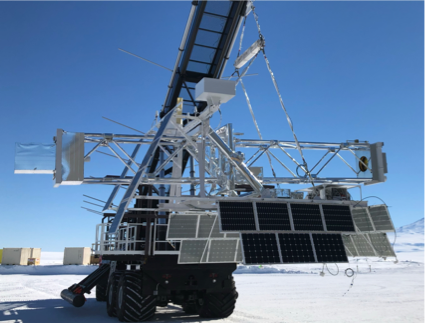
The XL-Calibur mission is a balloon-borne
X-ray telescope flown in July 2022 and again in July 2024 from Kiruna, Sweden.
The first flight was compromised by ballast issues that prevent science operations
whilst the second was fully successful: both flights ended after roughly 5 days
as the balloon was landed in northern Canada. The balloon circled the polar region
at stratospheric attitudes
(roughly 39.6 km; 130,000 feet) where atmospheric attenuation of X-rays
is reasonably slight.
A proof-of-concept mission, X-Calibur, was previously flown in the Earth’s stratosphere
from McMurdo Station in Antarctica (29 Dec 2018 - 1 Jan 2019).
X-Calibur was also flown in a much shorter test flight in September 2016
from Fort Sumner, New Mexico; no astrophysical data was collected, but
the instruments did characterized the high-altitude background noise
environment.
XL-Calibur uses a flight spare X-ray telescope from the Hitomi mission
with a 12 m focal length, mounted in a carbon fibre tube and
aluminium optical bench truss: the X-Calibur Dec 2018 flight used the smaller
INFOCμS mirror, which also had a shorter 8 m focal length.
The detector is sensitive to the linear polarization
of the incident hard X-rays. The instrument is shielded from atmospheric
gamma- and cosmic rays with anti-coincidence shielding. The
system is deployed in a gondola beneath a balloon
and at the end the mission, the apparatus is parachuted back to the surface and
recovered for reflight. The flight program calls for a modest list of proposed
targets in the northern (Kiruna) and southern (McMurdo) skies; The December
2018 flight observed GX 301-2 and Vela X-1, but was cut short late in on Jan 1 2019
when the balloon developed a leak.
Mission Characteristics
 Lifetime
Lifetime :
July 2022, July 2024 (Kiruna, Sweden)
 Energy Range
Energy Range : 15–60 keV
 Special Features
Special Features : linear polarization measurements in hard X-ray regime
 Payload
Payload :
- Polarimeter. The detector is a single beryllium rod, surrounded by
Cadmium Zinc Telluride (CZT) detectors (2mm thick CZT in X-Calibur; 0.8 mm thick
in XL-Calibur). A CZT detector at the rear of the scattering rod is used to
monitor the position of the source within the field of view.
The detector is also equipped with Bismuth Germanium Oxide (BGO) anti-coincidence
detectors to shield the instrument to background radiation.
- Energy range : 15–60 keV
- Effective area : 180 cm2 at 30 keV (XL-Calibur)
- Focal length : 8 meter (X-Calibur); 12 meter (XL-Calibur)
- Angular resolution : ∼2 arcmin
- Timing resolution: ∼1 μs
- Energy Resolution: < 7 eV at 6 keV
- Mirror Assembly and Support Truss. For XL-Calibur, the mirror is
a flight spare from the Hitomi Hard X-Ray Telescope, and originally made
for the FFAST mission.
The mirror and detector assembly are mounted at opposite ends of a truss (12 m
for XL-Calibur; 8 m long in X-Calibur) made of aluminium-carbon fibre
- Wallops Arc Second Pointer (WASP). The truss system with mirror and
detector is mounted on a gondola equipped with the WASP pointing system.
The system is designed to achieve absolute pointing knowledge to 15 arcsec
accuracy and pointing precision of less than 1 arcsec.
 Science Goals
Science Goals:
- Observation of hard X-ary emission from stellar-mass black hole in X-ray binaries and constrain
the property of X-ray bright coronas.
- Distinguish between competing emission models of the rotation-powered Crab pulsar and cleanly
separate contributions from the pulsar and from the nebula.
- Measurements of highly-magnetised accreting pulsars at the energies of their Cyclotron Resonant Scattering Features, where the competition of QED and plasma birefringence is expected to give high and strongly energy-dependent polarisation
 Archive
Archive: HEASARC hosts XL-Calbiur data, products, and catalogs.